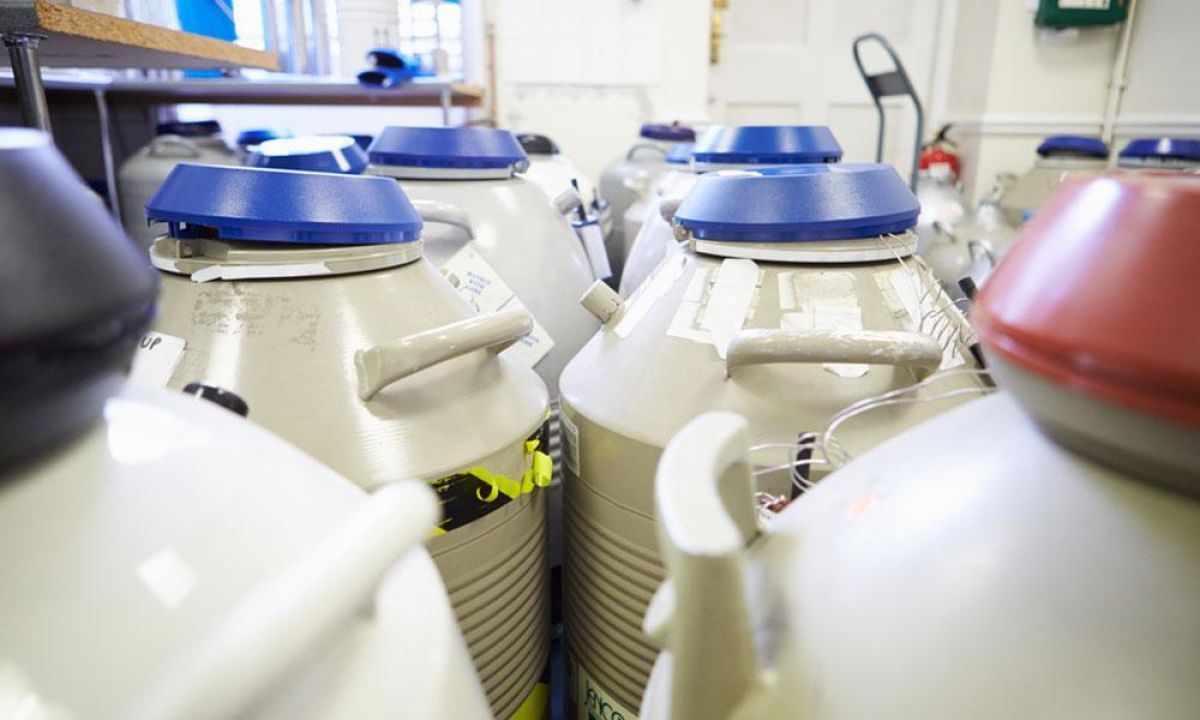Secure Storage of Frozen Eggs and Embryos at CCRH and In Vitrotech Labs

Secure Storage of Frozen Eggs and Embryos at CCRH and In Vitrotech Labs
We at CCRH and In Vitrotech Labs were saddened to hear of the devastating incident involving a cryotank malfunctioning at two fertility centers earlier this month.
We want to reassure our patients that this is an exceedingly rare event and extremely unlikely to happen at our Center.
It is important to understand how cryotanks work. Cryotanks are best thought of as giant thermoses. They are often cylindrical, approximately the size of a washer unit. The tanks have thick insulation in the walls and the bottom, with a thick insulated lid, and are filled with liquid nitrogen. There is no electrical power that keeps the tank cold, it’s the liquid nitrogen contained in the tank that maintains the low temperature.
Liquid nitrogen boils at minus 196 degree Celsius. The temperature at the surface of the liquid will always be warmer, and therefore the liquid nitrogen is constantly evaporating and will therefore need to be replenished.
All the eggs, embryos, and sperm are placed in very tiny containers, called “straws and vials” and kept submerged in the liquid nitrogen. At this temperature, there is no biological activity and therefore no deterioration of the biological tissue. As long as the samples are stored completely submerged in the liquid nitrogen, they can be kept indefinitely.
With the reported incidents, the drop in liquid nitrogen level and subsequent temperature fluctuation in the cryotanks may have affected the viability of the eggs and embryos.
At In Vitrotech Labs, our tanks are continuously monitored and equipped with an alarm system. If the liquid nitrogen falls below a threshold, the alarm system will not only sound in the lab, it will also immediately send a first phone call to our lab director. If she doesn’t answer the call, a second phone call from alarm system will be sent to another senior embryologist. If the second phone call is also missed by the senior embryologist, then a third phone call will be sent to our lab assistant—the status of the cryotanks in our lab are monitored 24/7.
Furthermore, the liquid nitrogen level in the cryotanks are visually checked daily, and the tanks refilled to the maximum capacity, “topped-off” every other day. With the lid closed, the normal rate of evaporation in our tanks will take approximately two weeks before the level drops below a concerning threshold. In our laboratory, we additionally set a higher liquid nitrogen threshold to ensure even if the liquid nitrogen level reaches the threshold, specimens stored in the tanks will still be completely submerged in the liquid nitrogen.
Eliran Mor, MD
Reproductive Endocrinologist located in Encino, Valencia & West Hollywood, CA
FAQ
What does a reproductive endocrinologist and infertility specialist do?
Reproductive endocrinology and Infertility is a sub-specialty of Obstetrics and Gynecology. In addition to managing medical and surgical treatment of disorders of the female reproductive tract, reproductive endocrinologist and infertility (REI) specialists undergo additional years of training to provide fertility treatments using assisted reproductive technology (ART) such as in vitro fertilization.
Reproductive endocrinologists receive board certification by the American Board of Obstetrics and Gynecology in both Obstetrics and Gynecology and Reproductive Endocrinology and Infertility.
When should I see an REI specialist?
In general, patients should consider consulting with an REI specialist after one year of trying unsuccessfully to achieve pregnancy. The chance of conceiving every month is around 20%, therefore after a full year of trying approximately 15% of couples will still not have achieved a pregnancy.
However, if a woman is over the age of 35 it would be reasonable to see a fertility specialist earlier, typically after 6 months of trying.
Other candidates to seek earlier treatment are women who have irregular menses, endometriosis, fibroids, polycystic ovary syndrome (PCOS), women who have had 2 or more miscarriages, or problems with the fallopian tubes (prior ectopic pregnancy).
What are the reasons we are having trouble conceiving?
Approximately 1/3 of the time cause for infertility is a female factor, 1/3 of the time a male factor, and the remaining 1/3 a couples’ factor.
At CCRH, we emphasize the importance of establishing a correct diagnosis. Both partners undergo a comprehensive evaluation including a medical history and physical exam.
Furthremore, the woman’s ovarian reserve is assessed with a pelvic ultrasound and a hormonal profile. A hysterosalpingogram (HSG) will confirm fallopian tube patency and the uterine cavity is free of intracavitary lesions. A semen analysis is also obtained to evaluate for concentration, motility, and morphology of the sperm.
Additional work up is then individualized to direct the best possible treatment option for each couple.
What is IVF? What is the process like?
In vitro fertilization (IVF) is the process that involves fertilization of an egg outside of a woman’s body.
The process starts with fertility drugs prescribed to help stimulate egg development. In your natural cycle, your body is only able to grow one dominant egg, but with stimulation medication we can recruit multiple eggs to continue to grow. After about 8-10 days of stimulation, the eggs are surgically retrieved and then fertilized with sperm in a specialized laboratory. Fertilized eggs are then cultured under a strictly controlled environment within specialized incubators in the IVF laboratory for 3-5 days while they develop as embryos. Finally, embryos (or an embryo) are transferred into the uterine cavity for implantation.
Should I have IVF?
Before deciding if IVF is the right choice, it’s important to sit down with an REI specialist to discuss available treatment options. For some people, other methods such as fertility drugs, intrauterine insemination (IUI) may be the best first choice treatment. At CCRH, we believe each individual couple is unique and not everyone needs IVF.
Is the IVF procedure painful?
While not painful, the fertility medications may some side effects including headaches, hot flashes, mood swings, and bloating. The injection sites may also bruise.
Will IVF guarantee a baby?
Unfortunately, no. Many people think once they start IVF it’s a matter of time that they will be pregnant and have a baby. But according to national statistics per the Society of Assisted Reproduction (SART), on average 40% of assisted reproduction cycles achieve live births in women under age 35. The chances of success then continue to decrease with advancing age.
At CCRH, we employ only evidence-based interventions to ensure patient safety and optimal outcome. While we cannot guarantee a baby, we guarantee that you will receive the best, most advanced, personalized care to help you maximize your chance of a baby.
What is the success rate for IVF?
The average IVF success rate (success measured in live birth rate) using one’s own eggs begins to drop around age 35 and then rapidly after age 40. This is due to the decline in egg quantity and egg quality as a woman ages.
Our clinic’s success rate consistently beats the national average year after year.
Do insurance plans cover infertility treatment? How much does IVF cost?
Individual insurance plans often do not have any coverage for infertility treatments. If you have a group plan, you can call members services to see if they have coverage for infertility (including consultation/workup and IVF).
After your consultation with our REI specialist, one of our dedicated account managers with sit with you to go over the cost of treatment.




